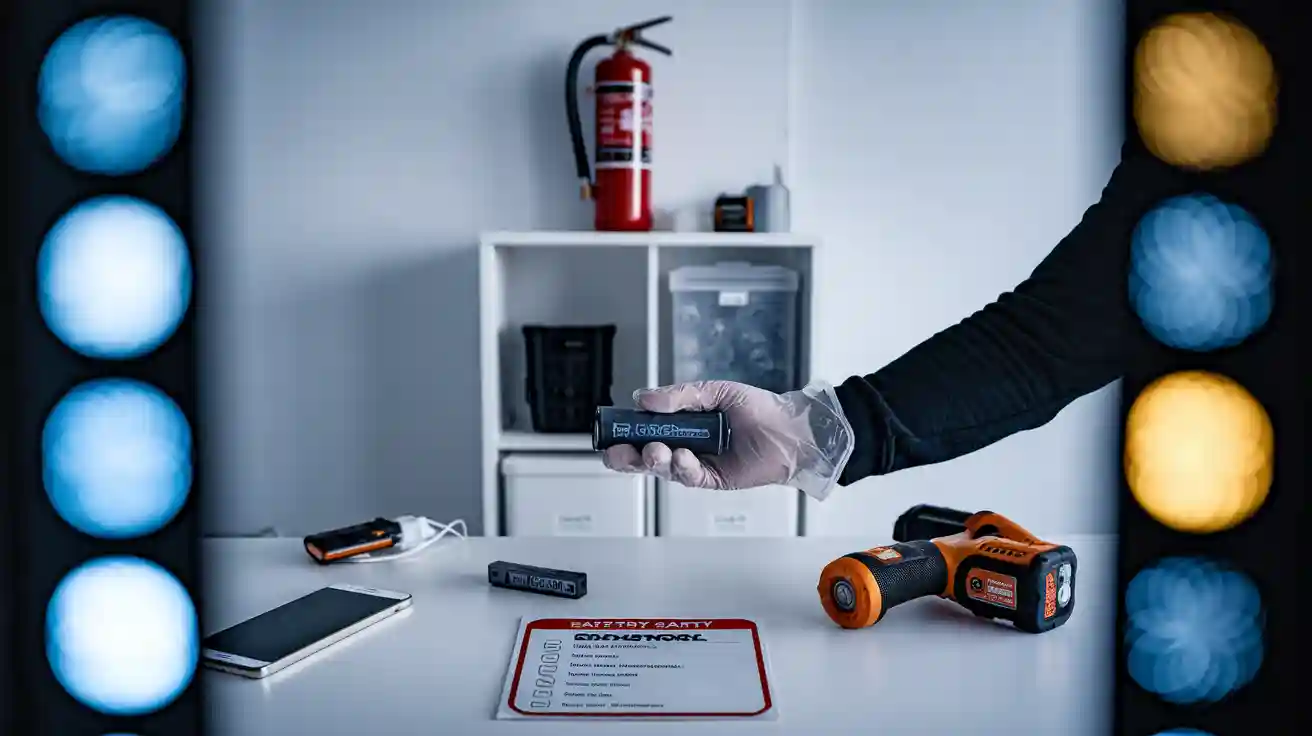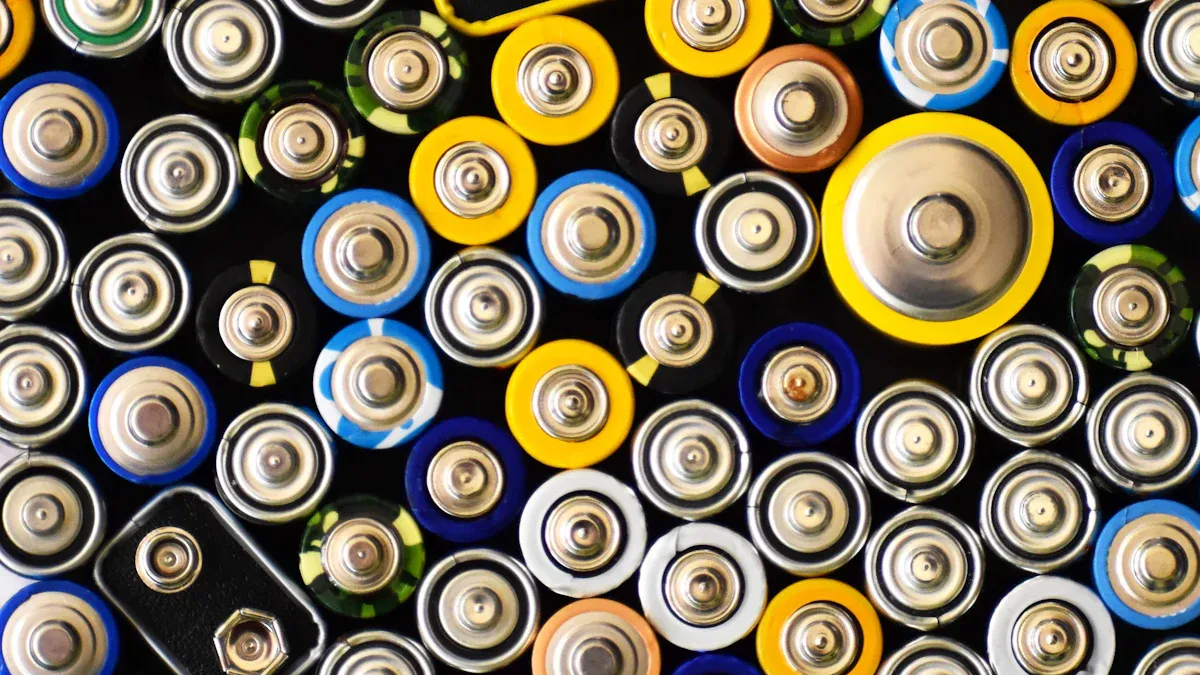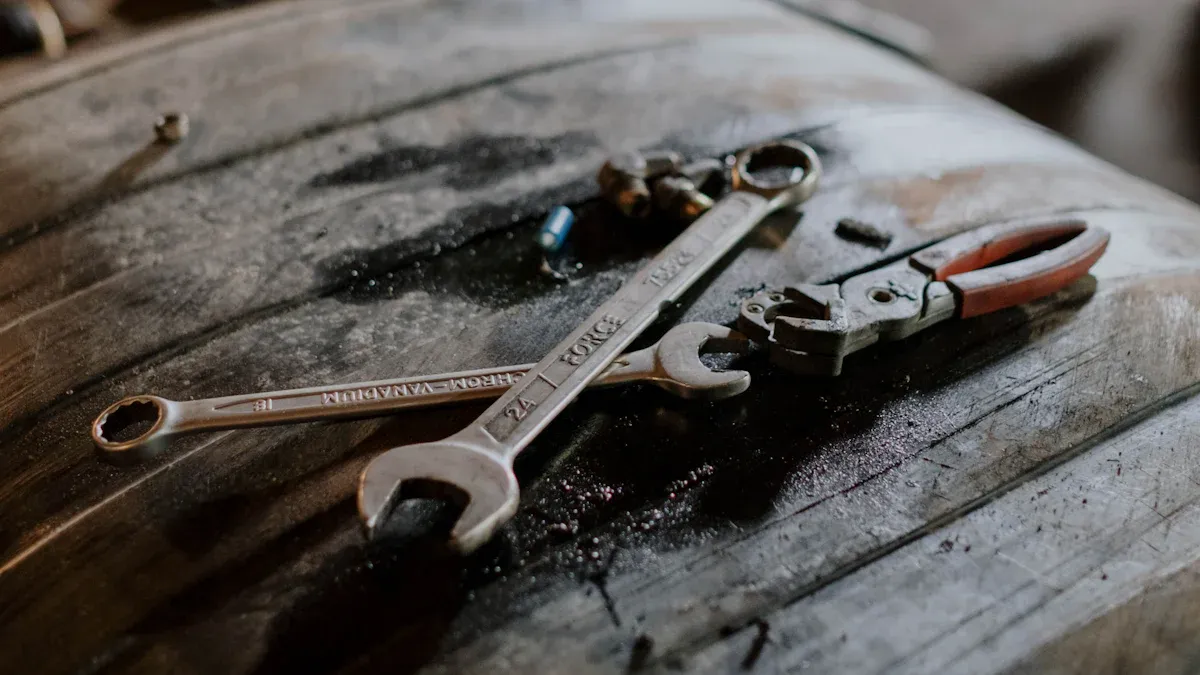
You might worry about a lithium-ion battery leak at home. These batteries power your phones, laptops, and many other devices. You can keep your home safe by following a safety first approach with every battery you use. Most leaks happen because of things such as short circuits, too much moisture inside the battery, aging protection circuits, or overcharging. Sometimes, a battery can leak after a drop or a hard hit. You can prevent most lithium-ion battery leaks with simple steps. Always check your batteries for damage and store them safely. Safety first keeps your family and your devices protected.
- Common causes of lithium-ion battery leaks at home:
- Short circuits inside or outside the battery
- High moisture inside the battery
- Weak protection circuits
- Overcharging or letting the battery run too low
- Physical damage from drops or bumps
Safety First Steps
Safe Charging
Charging your lithium-ion batteries the right way is one of the most important steps you can take for safety and prevention. Always use a charger that matches your battery’s chemistry and capacity. This helps you avoid overheating and other hazards. You should keep the charging voltage and current within the limits set by the manufacturer. Most lithium-ion batteries use a Метод зарядки постоянным током и постоянным напряжением (CC-CV). This method keeps your battery safe and helps it last longer.
Совет: Charge your lithium-ion battery in a room with a temperature between 59°F and 95°F (15°C to 35°C). Charging outside this range can cause damage or speed up battery wear.
You should avoid charging your battery below 32°F (0°C) or above 113°F (45°C). Extreme temperatures can lead to leaks or even battery failure. Try not to let your battery fully discharge or charge to 100% all the time. Keeping your battery between 20% and 80% charge helps extend its life and prevent lithium-ion battery leaks.
Many devices have a Battery Management System (BMS). This system monitors voltage, current, and temperature. It protects your battery from overcharging, overheating, and thermal runaway. If you notice your battery swelling, getting hot, or acting strangely during charging, stop using it right away. Dispose of swollen or defective batteries safely to avoid hazards.
- Use only chargers designed for your lithium-ion battery.
- Charge in a cool, dry place away from sunlight.
- Do not leave charging batteries unattended.
- Check the battery for heat, swelling, or leaks during charging.
- Store unused batteries at about 50% charge.
Советы по хранению
Proper storage is key to prevent lithium-ion battery leaks and keep your batteries safe. You should always remove the battery from the device if you plan to store it for a long time. Charge or discharge the battery to about 40%-60% before storage. This level helps maintain battery health and reduces the risk of leaks.
- Store your lithium-ion batteries in a dry, well-ventilated area.
- Keep the temperature between 41°F and 77°F (5°C to 25°C) for short-term storage. For long-term storage, 50°F to 86°F (10°C to 30°C) is best.
- Protect the battery terminals with insulating materials to prevent short circuits.
- Place batteries in fireproof containers or LiPo safe bags for extra protection.
- Avoid storing batteries near heat sources, direct sunlight, or flammable materials.
- Recharge stored batteries every 3 to 12 months to keep them healthy.
- Keep batteries away from static electricity and strong magnetic fields.
Примечание: Heat and sunlight can cause lithium-ion batteries to overheat. This can lead to gas buildup, swelling, and leaks. Always store your batteries in a cool, shaded place.
Never store batteries with loose metal objects. This can cause short circuits and damage. If you notice any damaged batteries, do not seal them in plastic bags. Use a LiPo safe bag or a fireproof container instead.
Handling Lithium-Ion Batteries
Careful handling of lithium-ion batteries helps you avoid damage and keeps your home safe. Always check your batteries for signs of damage before use. Look for swelling, bulging, leaks, or unusual heat. If you see any of these signs, do not use the battery. Dispose of it according to local rules.
- Handle batteries gently to avoid drops or impacts.
- Use protective cases for devices to prevent accidental damage.
- Avoid using low-quality or counterfeit batteries. These often lack proper protection and can increase the risk of leaks.
- Regular inspection is important. Make it a habit to check your batteries for physical damage and performance changes.
- If you find a damaged lithium-ion battery, do not try to repair or reuse it. Safe disposal is the best option.
Precautions: Always choose high-quality lithium-ion batteries from trusted brands. Good quality means better protection and a lower risk of leaks.
By following these safety first steps, you can prevent lithium-ion battery leaks and protect your home. Make prevention and regular inspection part of your routine. Handle, charge, and store your lithium-ion batteries with care to keep your family and devices safe.
Why Lithium Batteries Leak
Lithium batteries power many devices in your home, but they can leak if you do not use or store them properly. Understanding why lithium batteries leak helps you lower the risk of leakage and keep your family safe.
Перезарядка
When you overcharge a lithium-ion battery, the voltage rises above safe limits. This causes the electrolyte inside to break down and release gases. The pressure inside the battery increases, which can make the battery swell or burst. Перезарядка not only shortens battery life but also raises the risk of leakage and fire. Most modern lithium-ion batteries have built-in safety features to prevent overcharging, but you should still watch charging times and use the right charger. Never leave batteries charging overnight or unattended.
Физический ущерб
Physical damage is a major reason why lithium batteries leak. Dropping, puncturing, or crushing a battery can crack the casing or break the seals. This lets the electrolyte escape, creating leaky batteries. Damaged batteries may also short-circuit, which increases the risk of leakage and fire. Always handle lithium-ion batteries with care. If you see swelling, dents, or other signs of damage, stop using the battery right away.
Poor Storage
Storing lithium batteries in hot, humid, or poorly ventilated places increases the risk of leakage. High temperatures speed up chemical reactions inside the battery, which can cause swelling, gas buildup, and leaks. Moisture can corrode metal parts and damage the battery’s internal structure. You should always store lithium-ion batteries in cool, dry places with stable temperatures. Avoid leaving batteries in cars or near heat sources.
- High temperatures increase the risk of thermal runaway, swelling, and venting.
- Excessive moisture causes corrosion and short circuits.
- Poor ventilation leads to gas buildup and leaks.
Design or Quality Issues
Battery quality matters. Poor manufacturing, low-quality materials, or counterfeit products can make lithium batteries leak. Defective batteries may have weak seals, missing safety features, or poor voltage control. These problems raise the risk of leakage, fire, and even explosions. Always buy lithium-ion batteries from trusted brands and check for safety certifications. Certified batteries go through strict testing to lower the risk of leakage.
| Mechanism Type | Пояснение |
|---|---|
| Manufacturing Defects | Poor welding or sealing, bad materials, or gaps in seals can cause a lithium-ion battery leak. |
| Chemical Corrosion | Moisture reacts with the electrolyte, damaging the battery and raising the risk of leakage. |
| Физический ущерб | Drops, punctures, or swelling can crack the battery and cause leaks. |
| Excessive Internal Pressure | Gas buildup from improper use or overcharging leads to leaks. |
Примечание: Термическое разрушение is a dangerous chain reaction in lithium-ion batteries. When the battery gets too hot, it can heat up even more, causing the electrolyte to break down and release flammable gases. This can make the battery vent, leak, or even explode. Always follow safety tips to lower this risk.
Check If a Lithium Battery Is Leaking

Knowing how to check if a lithium battery is leaking helps you keep your home safe. You can spot problems early by using your eyes, nose, ears, and by watching how your devices work. Always act fast if you notice any warning signs.
Visual Signs
Start with a visual inspection. Look closely at your lithium-ion batteries for any changes. Some signs of a lithium-ion battery leak are easy to see:
- Wet spots, color changes, or sticky residue on the battery casing.
- Corrosion or strange substances on the battery contacts or terminals.
- Swelling or bulging of the battery casing, sometimes called a “spicy pillow” or puffy battery.
- Physical deformities like a warped shape or a screen being pushed out of its frame.
If you see any of these, stop using the battery right away. Place it in a safe area and follow safety steps.
Совет: Never ignore swelling or leaks. These signs mean the battery could fail soon.
Smell and Sounds
Your nose and ears can help you find a lithium-ion battery leak. A leaking battery often gives off a strong, unusual smell. Many people say it smells sweet, metallic, or like nail polish remover. You might also hear a faint hissing sound. This happens when gas escapes from inside the battery. Both the smell and sound mean the battery’s seal is broken and dangerous chemicals are leaking out. If you notice these, open a window, move the battery to a safe spot, and avoid breathing in the fumes.
Performance Changes
Sometimes, you will not see or smell a leak right away. Instead, your device may start acting strange. You might notice the battery drains faster, takes longer to charge, or the device shuts off without warning. These changes can mean the lithium battery is damaged inside. Scientists found that a leaking lithium-ion battery may not show a quick drop in voltage, but other problems like higher internal resistance, less power, and slower charging can appear. Watch for these performance changes, especially if you already see other warning signs.
If you suspect a lithium-ion battery leak, take action right away. Remove the battery from your device if it is safe to do so. Place it in a fireproof container and contact a recycling center or local authority for help. Quick action keeps you and your family safe from harm.
Safety Response

When you suspect a lithium-ion battery leak, you need to act quickly and carefully. A clear safety action plan helps you lower the risk of injury or damage. This section guides you through the right steps for immediate response, safe disposal, and knowing when to seek help.
Immediate Actions
If you notice a lithium-ion battery leak, follow these steps to protect yourself and your home:
- Inspect the battery for visible damage like swelling, cracks, or leaking fluid.
- Avoid touching the leaked material. Wear gloves and eye protection if you must handle the battery.
- Move the battery away from flammable items and place it on a non-combustible surface, such as concrete or tile.
- Ventilate the area by opening windows. Toxic gases from a leaking battery can cause skin, eye, and breathing problems.
- If you hear hissing, see smoke, or smell strong odors, keep a safe distance. Do not try to clean up or move the battery if it is reacting.
- Use a fireproof container or a certified lithium-ion battery storage box to contain the battery. Make sure the terminals do not touch metal or other batteries.
- Clean any leaked electrolyte with a disposable cloth, but avoid direct contact. Wash your hands well after handling anything near the leak.
- If you get battery chemicals on your skin or in your eyes, rinse with water for at least 15 minutes and seek medical attention.
Совет: Never seal a damaged battery in a plastic bag. Always use a fireproof or approved container for storage and transport.
A leaking lithium-ion battery can release dangerous chemicals like hydrofluoric acid and toxic gases. These can cause burns, breathing trouble, and other health risks. Always treat a leak as a serious hazard.
Безопасная утилизация
Proper disposal of a leaking or damaged lithium-ion battery is important for safety and environmental protection. You should never throw these batteries in the regular trash. Follow these steps for safe disposal:
- Identify damaged batteries by signs like swelling, leaking, burn marks, or cracks.
- Isolate the battery in a non-flammable, fire-resistant container. Keep it away from people and pets.
- Use gloves and other protective gear when handling the battery.
- Do not ship damaged lithium-ion batteries by air. Follow local and national rules for packaging and transport.
- Contact a professional recycling service, such as Battery Recyclers of America, for guidance on safe disposal. Many programs offer pickup or drop-off options for damaged batteries.
- Check the device manufacturer’s website or the Consumer Product Safety Commission for recalls or special instructions.
- Always follow the U.S. Department of Transportation Hazardous Materials Regulations for shipping and disposal.
Примечание: Safe disposal prevents fires, explosions, and toxic leaks in landfills. Recycling centers have the right tools and knowledge to handle lithium-ion batteries safely.
When to Get Help
Some situations require professional help. You should seek assistance if:
- The battery is smoking, sparking, or on fire. Evacuate the area and call 911.
- You cannot safely move or contain the battery.
- You feel sick after exposure to battery chemicals. Symptoms may include coughing, trouble breathing, skin rashes, or eye irritation.
- The leak affects a large area or multiple batteries.
- You are unsure about the right disposal method.
Professional emergency services and environmental health teams have the training and equipment to manage lithium-ion battery leaks. They can reduce the risk of fire, chemical exposure, and environmental harm.
Вызов: If you ever feel unsafe, always put your safety first. Wait for trained professionals to handle the situation.
A strong safety action plan and good management of lithium-ion batteries protect your home and health. Quick response, proper containment, and safe disposal lower the risk of leaks and keep your environment safe.
You can keep your home safe by making safety first your top priority with lithium-ion batteries. Always choose certified devices, follow manufacturer instructions, и use only the correct charger. Inspect your lithium batteries each week for cracks, swelling, or leaks. Teach your family to spot warning signs like heat, odor, or strange noises. Share what you learn about battery safety. These habits protect your home and help everyone handle lithium-ion batteries with care.
ЧАСТО ЗАДАВАЕМЫЕ ВОПРОСЫ
What should you do if a lithium-ion battery starts leaking?
Move the battery to a safe, non-flammable surface. Wear gloves and avoid touching the leaked material. Ventilate the area. Place the battery in a fireproof container. Contact a recycling center or local authority for safe disposal.
Can you still use a swollen lithium-ion battery?
Never use a swollen battery. Swelling means the battery is damaged and unsafe. Using it can cause leaks, fires, or explosions. Replace it with a new, certified battery right away.
How can you tell if a lithium-ion battery is fake?
- Check for missing safety labels or certifications.
- Look for spelling errors on packaging.
- Compare weight and size with a genuine battery.
- Buy only from trusted stores or brands.
Is it safe to store lithium-ion batteries in the refrigerator?
Do not store lithium-ion batteries in the refrigerator. Cold temperatures can cause condensation, which leads to corrosion and damage. Store batteries in a cool, dry place at room temperature for best safety.

